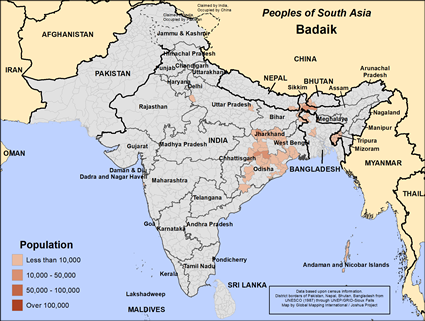Badaik in India

Send Joshua Project a photo
of this people group. |

Map Source:
People Group data: Omid. Map geography: UNESCO / GMI. Map Design: Joshua Project.
|
| People Name: | Badaik |
| Country: | India |
| 10/40 Window: | Yes |
| Population: | 120,000 |
| World Population: | 120,000 |
| Primary Language: | Sadri |
| Primary Religion: | Hinduism |
| Christian Adherents: | 0.00 % |
| Evangelicals: | 0.00 % |
| Scripture: | New Testament |
| Ministry Resources: | Yes |
| Jesus Film: | Yes |
| Audio Recordings: | Yes |
| People Cluster: | South Asia Hindu - other |
| Affinity Bloc: | South Asian Peoples |
| Progress Level: |
|
Introduction / History
The Badaik also called Chik and Chik-Bakaik. Like many low class communities, the Badaik are discriminated against by higher castes Hindus. Their children are often not allowed to attend schools with other Hindus.
The traditional occupation of the Badaik was weaving mats, baskets and fans.
The two main languages of the Badaik are Sadri and Bengali. The New Testament is available in Sadri. The JESUS Film has been translated into Sadri. Many resources are available in Bengali including radio programs. There are few if any Badaik believers.
The Badaik people live in northeast India. Most Badaik reside in the Indian states of West Bengal, Jharkhand and Odisha.
What Are Their Lives Like?
Until the middle of the 20th century, the Badaik were dependent on weaving for their livelihood. Modern factories can make these items with lower costs and more quickly. As a result, most Badaik now work in agriculture on land owned by others. Urban Badaik work in factories and in construction. Rural Badaik have retained their traditional crafts such as weaving, spinning, basketry, carpentry, and pottery. They sell these items to buy things they cannot make for themselves such as cell phones and appliances.
Unfortunately, the Badaik have not made significant gains in education. These is especially true for women and girls. Most men have at least a primary education. Rural Badaik people often lack access to electricity, clean water and modern medicine. Life expectancy is low while child mortality is high.
Badaik marry within their group. Monogamy or marriage to one spouse in the norm. The Badaik tend to have large families. Sons inherit their father's property and must take care of elderly relatives. Village elders make judicial decisions and enforce correct behavior.
What Are Their Beliefs?
Badaik religious practices draw from both Hinduism and animistic practices. Their Hindu worship is mostly devoted to Shiva, destroyer, one of Hinduism's main three gods.
Hinduism is the ancient religion of India. Hinduism is a catch-all phrase for the local religions of South Asia, so it is very diverse. At the popular level, Hindus worship and serve the gods of the Hindu pantheon. They visit Hindu temples and offer prayers, food, flowers, and incense to their gods in hopes of gaining protection and benefits. They do not have a personal or familial relationship with their gods as Christians do. As a low class community, the Badaik have their own priests and shrines.
Almost all Hindus participate in yearly celebrations like Holi, the festival of colors and the start of spring / Diwali, the festival of lights / Navratri, the celebration of autumn / and Rama Navami, Rama's birthday.
What Are Their Needs?
The Badaik people have huge spiritual and physical needs. The greatest need is for God's love and forgiveness that is offered to them in the person and works of Jesus Christ.
Prayer Points
Pray that the Badaik people will soon see the light of Christ and forsake all other gods.
Pray for the Lord to send out loving workers to the Badaik people of India.
Pray the Badaik parents will be able to provide for their children.
Ask the Lord to raise up a growing church among the Badaik in this decade.